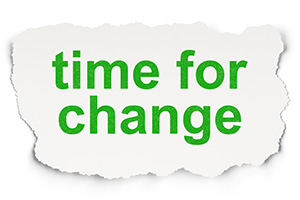 “No one likes change.”
“No one likes change.”
It’s one of those statements we’ve all heard so often in business that we’ve come to accept it as fact. No one likes change. On face value, it seems reasonable. We can all think of some organizational change initiative that was met with resistance by a few (or many) vocal opponents, so anecdotally the statement seems to hold water.
But look past the failed change initiatives and think about the ways we seek out change every day. We buy new cars and homes. We meet new people and build relationships. We start families and change careers. The only constant in our world is change. So, it’s an oversimplification to say “no one likes change.” Next time you hear that phrase, challenge the individual to explain the statement and dig for the deeper issue.
What you’ll find beneath the surface is a core problem that can be addressed proactively.
It’s not that no one likes change, but most people are uncomfortable with the unknown. A fundamental requirement for any change initiative is a strong communication plan. When this crucial step is overlooked, it signals a few things. First, there may be a mentality of “why go to the trouble of explaining the change when no one has a choice anyway.” Second, it signals a key step has been overlooked in the process, which likely means other steps (like gathering feedback and gaining buy-in) have likely been skipped, as well. Finally, it signals a fundamental disconnect on a human level. When change initiatives are led from the top and the details of the change and future impact haven’t been communicated thoroughly to the front lines of the organization, it creates a clear segmentation between the inner circle and outer circle.
It’s not that no one likes change, but no one likes being overlooked. When most people learn about an upcoming change, they often ask discovery questions from their vantage point.
- “Did they consider X?”
- “How will they deal with Y?”
- “Did anyone ask for feedback about Z?”
From a high level, what they want is to feel comfortable with the level of due diligence that was taken before defining the change initiative. But at the core, what everyone is thinking is “why didn’t they ask us?” Feeling overlooked or insignificant creates resentment and then often translates into both resistance and/or defiance.
It’s not that no one likes change, but no one likes feeling unsafe. A job is never just a job. A job is the means by which a family is sustained. So when change initiatives leave more questions than answers, and the future feels tumultuous, we feel as if more than just our jobs are at stake. Our whole lives hang in the balance. When your employees worry whether they will have a paycheck next month, they cannot bring their best to the job and everything begins to suffer. Performance, relationships, customer satisfaction, and engagement will all decline when your employees are worried about their stability.
Finally, it’s not that no one likes change, but no one likes feeling unsupported. Another common response I hear from the front lines of change initiatives is “well, who’s going to take care of X?” This is the snowball effect of poorly designed change initiatives. It begins with feeling like their current processes/responsibilities were overlooked and ends with the assumption that more work is being piled on an already full plate. Often, the most engaged employees will feel frustrated, yet take on the extra work without expressing discontent because they’re upwardly supportive and committed to the organization. This, of course, only lasts for so long before signs of burnout will emerge.
At the heart of these change-resistance issues are trust and communication. When there is low trust across the organization and a failure to effectively communicate through the entire change initiative (from discovery through implementation), the plan will surely fail. Building trust and communicating effectively both take time, but it takes far less time that than what will be lost dealing with disengagement and internal resistance.
Learn more about how to equip your leaders for effective change management here.
